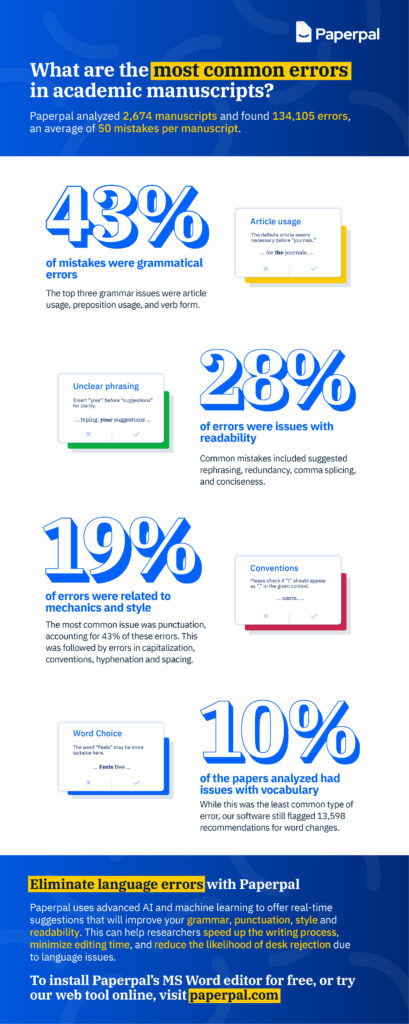Publication in a string of high-profile academic journals is the Holy Grail of a researcher’s career. Naturally, this is not an easy achievement. Not only must academics be experts in their field, they must also be able to communicate their research ideas succinctly in writing — this is a big ask, and not everyone gets it right! Here Neeraj Sanghani, Business Head of Products at Paperpal, shares insights into the most common errors found in academic papers, and explains how researchers can avoid them with simple language and grammar checks online.
Being an expert in an academic field doesn’t automatically guarantee a researcher can produce a well-written manuscript. Most academic training focuses on research specifics such as study design, methods, and data collection, rather than on academic writing and the English language. However, a research manuscript that is difficult to read is as likely to be rejected as an article with an inappropriate study design. This highlights the importance for authors to develop high-quality academic writing skills and do the language and grammar checks online before they submit.
English grammar is complex, and it’s difficult for authors, especially those with English as a second language, to know how and what to check in their work. So we turned to Paperpal’s advanced AI tool to come up with some insights. Based on the expertise of leading professional academic editors, the software offers unbiased language feedback by learning how human editors enhance manuscripts for journal submission. This ensures that the corrections Paperpal suggests are on par with those of a human editor. In fact, a University of Cambridge study of the online language editing tools available has named Paperpal as the most appealing tool for researchers and best suited to academic writing.
To identify the most common errors researchers make in their writing, we used Paperpal to analyze 2,674 pre-edited research papers. The infographic below highlights the key findings based on our analysis, some of which may surprise you.
Grammar
Across 2,674 papers, the tool identified 134,105 errors, with an average of 50 per manuscript. In our sample, 43% of flagged errors were related to grammar. The top three grammar issues were article usage, preposition usage, and verb form.
Because most researchers haven’t been explicitly taught English grammar since their early school days, identifying grammatical mistakes may be a challenge. This difficulty can be exacerbated for researchers who speak English as a second language who may find it more difficult to express their ideas.
Readability
Of the errors identified, 28% were issues with readability. Readability is critical in academia; even if a paper carries groundbreaking research, a peer-reviewed journal will be unable to publish it without extensive language corrections. The most common readability issues included suggested rephrasing, redundancy, comma splicing, and conciseness.
Mechanics and style
Issues related to mechanics and style made up 19% of identified errors. Interestingly, punctuation was by far the most common problem area, accounting for 43% of the mechanics and style corrections. This was followed by errors in capitalization, conventions, hyphenation, and spacing.
For confident writers, a careful proofread, reading the paper out loud, or running the tool through Word’s “Read Aloud” function, can help identify many mechanics and style issues. Some of the errors here may even turn out to be typos.

Vocabulary
Only 10% of errors identified pertained to vocabulary, making it the category that requires the least editorial correction. This may be because academics are well-versed in the best language for their research fields. However, the software flagged 13,598 recommendations to change word choice, showing that there was room for improvement.
Error-free academic writing
Finding a tool to perform grammar check online is fairly straightforward, but these tools are unlikely to be tailored to an author’s subject area and therefore may struggle to advance the author’s academic writing.
To overcome this, advanced AI-powered tools are starting to change the way researchers write their papers. For example, Paperpal has introduced a Word add-in that acts as a real-time AI writing assistant for researchers. The tool uses state-of-the-art machine learning and AI models to suggest real-time improvements in grammar, punctuation, style, and readability, helping researchers avoid these common language issues. Paperpal for Word is simple to use, helps polish your academic writing, minimizes editing time, and reduces the risk of desk rejection due to language issues. This also helps reduce the workload for journal editors, who can focus on the merits of the research, rather than be distracted by errors in the writing.
For real-time suggestions on your academic manuscript, use Paperpal for Word or get instant checks with Paperpal for Web. Visit our website to start now.
Paperpal is a comprehensive AI writing toolkit that helps students and researchers achieve 2x the writing in half the time. It leverages 21+ years of STM experience and insights from millions of research articles to provide in-depth academic writing, language editing, and submission readiness support to help you write better, faster.
Get accurate academic translations, rewriting support, grammar checks, vocabulary suggestions, and generative AI assistance that delivers human precision at machine speed. Try for free or upgrade to Paperpal Prime starting at US$19 a month to access premium features, including consistency, plagiarism, and 30+ submission readiness checks to help you succeed.
Experience the future of academic writing – Sign up to Paperpal and start writing for free!


